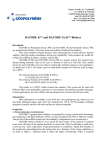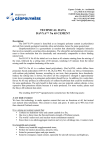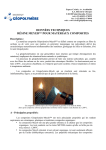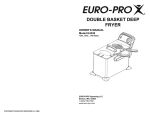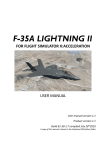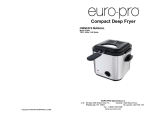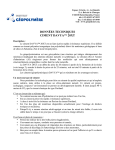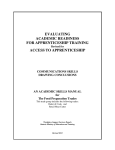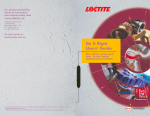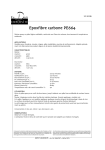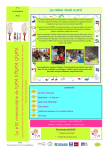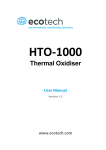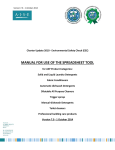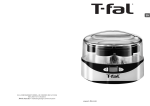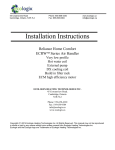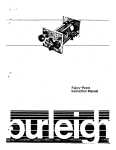Download Meyeb composite Properties
Transcript
Espace Créatis, Av. Archimède Z.A. Bois de la Chocque F-02100 Saint-Quentin, France tel:(+33) (0)323 67 8922 fax: (+33) (0)323 67 8949 web : www.cordi.geopolymer.org TECHNICAL DATA MEYEB™ RESIN FOR COMPOSITE MATERIALS Description: The material MEYEB Composite™ is described as a carbon composite with an inorganic polymer matrix (a polysialate) derived from the naturally non-flammable occurring geological materials silica and alumina, hence the name GEOPOLYMER or GÉOPOLYMÈRE in French. Geopolymerization is a geosynthesis (a reaction that chemically integrates minerals) involving natural and synthetic alumino-silicates. This geopolymerisation process allows to make a ceramic polysialate matrix, which together with carbon fibers yields flexible ceramics. Thermosetting occurs at 80°C or any lower temperature systems, even at room temperature. The resulting geopolymeric composites are fire resistant, non-flammable, light weight, and do not generate smoke and combustion gases. A Carbon-Epoxy aerospace composite (left) is burning while Carbon-GÉOPOLYMÈRE Composite™ (right) still resists a 1200°C fire. A – Main properties: Meyeb composites have three main properties that make them superior to ceramics, plastics, and organic composite materials: • Meyeb composites have a higher heat tolerance than organic composites. Tests conducted on a Meyeb resin showed that it will not burn at all, even at 1200°C. • Meyeb composites resist all organic solvents (and are only affected by strong hydrochloric acid). The mechanical properties of GeopolymerMeyeb composites are as good as those of organic composites (e.g. phenolic fiber reinforced composites). • Meyeb composites are very easy to produce, with curing temperatures in the range of 80° C and below. Before the discovery of geopolymerization, these three critical properties had not been incorporated into any composites. Meyeb Composites are: • fire resistant • non ignitable • non flammable • not producing combustion gases • non toxic • not emitting any smoke • relatively good heat shields • light weight (density 1.85) Use of conventional manufacturing processes: Several positive factors favoring MEYEB Composite™ include the ability to use existing processing machinery and technology. It is produced with processes and operation familiar to organic matrix users. In addition, it thermosets and cures at room and/or low temperature. Information: More information is available in our Web site, where you can download additional papers and order the Géopolymère Proceedings (Geopolymer 2005 and Geopolymer '99) including numerous scientific articles with tests and data on selected materials. B - Material characterizations: All tests performed have used a Meyeb-carbon composite (with a ratio of 20 parts by weight of MEYEB FS and 1 part by weight of MEYEB Hardener), with a thermosetting at 80°C, under a heated press and vacuum, to manufacture a high fire resistant product. With room temperature curing (with a ratio of 10 parts by weight of MEYEB FS and 1 part by weight of MEYEB Hardener), the mechanical properties are weaker (from -40 to -60%) after a high temperature exposure, depending on the fire resistancy of the fiber. However, the fire resistant barrier remains effective with any type of fibers. Fire Resistance Tests: (values taken from Richard E. Lyon, Andrew J. Foden, P. Balaguru, Joseph Davidovits and Michel Davidovics, Properties of Geopolymer Matrix-Carbon Fiber Composites, Fire and Materials, Vol. 21, 67-73 (1997) (see also the same paper in Geopolymer '99 Proceedings, pages 123-139). Comparison of the composite resin categories on the basis of percent residual flexural strength retained after the fire exposure is shown in Figure 1. The values represent a combined average for the thermoset (vinylester, epoxy), advanced thermoset (BMI, PI), phenolic, and engineering thermoplastic (PPS, PEEK). Composite Resin GEOPOLYMER 100 ENGINEERING THERMOPLASTIC 56 PHENOLIC 54 ADVANCE THERMOSET 20 THERMOSET 6 0 Fire Exposure 25 kW / m2 10 20 30 40 50 60 70 80 90 Residual Flexural Strength, Percent 100 Figure 1: Residual warp-direction flexural strength of crossply laminates after fire/thermal exposure Flashover is a phenomenon unique to compartment fires where incomplete combustion products accumulate at the ceiling and ignite causing total involvement of the compartment materials and signaling the end to human survivability. Consequently, in a compartment fire the time to flashover is the time available for escape and this is the single most important factor in determining the fire hazard of a material or set of materials in a compartment fire. The calculated values for time-to-flashover of organic and Geopolymer-Meyeb composites in a full scale room test shown in Figure 2 provide a qualitative ranking of the fire hazard of these materials in a compartment. The engineering thermoplastics are predicted not to reach flashover during the 20 minute ignition period but could generate appreciable smoke, while the Geopolymer-Meyeb composite will never ignite, reach flashover, or generate any smoke in a compartment fire. Figure 2: Predicted time to flashover in ISO 9705 corner/room fire test with various structural composites as wall materials. Table 1 compares some thermomechanical properties of fiber reinforced concrete, structural steel, a 7000-series aluminum used in aircraft structures, a phenolic- E glass fabric crossply laminate, a phenolic-carbon fabric crossply laminate, and the Geopolymer-carbon fabric crossply laminate. Maximum temperature capability is defined as the temperature in air at which the nominal tensile or flexural strength falls to one-half of its room temperature value. The Geopolymer-carbon fiber composite, even in the prototype configuration tested, significantly outperforms fiber reinforced concrete with regard to flexural strength and surpasses concrete and structural steel in temperature capability. Specific flexural strength is the flexural strength of the material divided by the bulk density and is the figure of merit for weight-sensitive applications such as aerospace and surface transportation vehicles. Similarly, specific modulus is defined here as the tensile (Young's) modulus of the material divided by its bulk density. In the case of the anisotropic crossply laminates the warp tensile modulus is used for the calculation. The Meyeb composite is superior to all of the materials listed with regard to specific modulus and is second only to the phenolic-carbon crossply laminate in specific strength. However, the Geopolymer-carbon fabric laminate is unique in its high temperature structural capability and fire resistance. Table 1. Typical Properties of Structural Material Density kg/m3 Tensile Modulus GPa Specific Modulus MPa-m3/ kg Flexural Strength MPa Specific Flexural Strength MPa-m3/ kg Maximum Temperature Capability °C Fiber-Reinforced Concrete 2300 30 13.0 14 0.006 400 Structural Steel 7860 200 25.4 400 0.053 500 7000 Series Aluminum 2700 70 25.9 275 0.102 300 1550 49 31.6 290 0.187 200 1900 21 11.0 150 0.074 200 1850 76 41.0 245 0.132 > 800 MATERIAL Phenolic-Carbon Fabric Laminate Phenolic-E Glass Fabric Laminate Geopolymer-Carbon Fabric Laminate 2 Table 3: Fire Calorimetry Data for Crossply Laminates at 50 kW/m Irradiance RESIN THERMOSETS ADVANCED THERMOSET PHENOLICS ENGINEERING PLASTICS Géopolymère-MEYEB Peak HRR Weight Loss % Time to Ignition Seconds kW/m 24 24 11 8 0 68 124 206 207 infinite 175 115 111 35 0 2 Average HRR Smoke kW/m Heat Release MJ/m2 99 86 66 22 0 33 43 23 15 0 1077 538 142 310 0 2 2 m /kg Table 3 summarizes all of the cone calorimeter data for the composite specimens. The data are the averages that are fairly representative of each type of material. It is clear that the Meyeb composite is non-combustible while all of the organic polymer matrix composites support flaming combustion. The results of the fatigue behavior are compared with the results for other composites and aircraft aluminum in Table 4. The fatigue endurance of the Geopolymer-Meyeb composite is far better than that of 2024-T3 aluminum as can be seen in Table 4. When compared to other high temperature composites such as BMI and PEEK the MEYEB composite is in the same range of failure load capacity for a given number of failure cycles. Table 4 Fatigue comparison of Stress Range Capacity for Given Number of Cycles to Failure Failure Cycles 107 106 105 104 GP-MEYEB 40% 45% 50% 65% 2024-T3 Aluminum 15% 20% 25% Bismaleimide (BMI) 50% - Poly(ether ether ketone) 50% 60% 70% Epoxy 35% 40% 50% C - Material characterizations for Infrastructure and Buildings Applications: A relatively new and very attractive repair method for concrete, brick and stone structures consists of externally bonding flexible sheets of fiber composites. Another application for continuous fiber composites in infrastructure, already well underway in Japan and USA is the wrapping of concrete columns to reinforce new construction and damaged bridges and buildings in earthquake and hurricane prone areas. In this application, particularly for exposed interior building columns, flammability is a serious concern. Fire safety is a concern often voiced by those who are skeptical about the use of composite materials in the infrastructure and building industry. Experiments by researchers at Rutgers University indicate that this composite material not only does not burn, but adheres better to concrete more effectively and reliably than organic materials, paving the way for use in strengthening both new concrete structures and enhancing old ones. "Géopolymère provides excellent adhesion both to concrete surface and in the interlaminar planes of fabrics;" states Prof. Bala Balaguru of Rutgers University. Géopolymère composites were affixed to concrete beams, and "all three beams failed by tearing of fabrics;" Balaguru reports. "This is significant because ... the most common failure pattern reported in the literature is the failure by delamination of fabrics at the interface of concrete and fabrics;' says the report. "Hence it can be stated that Géopolymère provides as good or better adhesion in comparison with organic polymers". Also, retrofitting of valuable Cultural Heritage buildings in Europe has to be considered where fire safety is the major concern. D – Carbon fiber and Glass fiber MEYEB composites Samples made using only E-glass fabric exhibit almost linear elastic behavior up to failure, and the failure is brittle and the stress five times lower than with carbon (see Fig. 3). This confirms that the bond between matrix and E-Glass is strong, and that the plate is acting as a homogeneous element. The S-glass plate exhibits less ductility than the carbon plates, but proved to be much more ductile than the E-glass composite. When alternating layers of E-glass and carbon are used, the reduction in strength is minimal. E-glass seemed to bond well with the matrix, providing a good interlaminar plate between carbon layers. Addition of E-glass layers increases the deflection at failure of the plate, which increased energy absorption before failure. However, there is a more brittle post peak loss of strength with these combined fabric plates. Since the elastic modulus of glass is much lower than carbon, the flexural modulus of these plates is lower than plain carbon plates. Apparent Flexural Stress (Mpa) 600 Unidirectional Carbon Unidir.-Carbon/E-Glass 500 400 300 200 E-Glass 100 0 0.0% 0.2% 0.4% 0.6% 0.8% 1.0% 1.2% Apparent Flexural Strain (%) Figure 3. Comparison of Plain Carbon Plates, Carbon/ E-glass Plates, and Plain E-glass Plates Note: The plain carbon sample’s stiffness is much higher yet. Strength is similar to Carbon/E-glass For more information on carbon-E-glass hybrid composites see the paper: James Hammell, P. Balaguru , Richard Lyon and Joseph Davidovits, Influence of reinforcement types on the flexural properties of Geopolymer composites, Geopolymer'99 Proceedings, pages 155-164 (1999). Directions for use MEYEB FS ™ A fire resistant resin for composite materials This MEYEB user’s manual describes the manufacture of a non flammable composite material. The lab. technician should use overall and gloves, and respect the safety and security rules that apply to his laboratory. No ventilation and no gas mask are required. The lab technician will be assisted by a second person in charge of cleaning the tools immediately in water, before the hardening begins. MEYEB FS should be kept in a freezer in a temperature lower than -18°C. The MEYEB resin can be used for 4 weeks (storage time after manufacturing date) when kept at this frozen temperature. There is a slight increase in the viscosity of the frozen resin, with the storage time, and a stronger increase between the 3rd and the 4th week. At this stage, the resin may still be used, because it becomes fluid again with the addition of the MEYEB HARDENER water solution (see step 2 below). To increase the pot-life of the resin, use a thermally insulated cup so that the resin remains cold as long as possible. If you have no freezer near you, you can take advantage of the MEYEB packaging parcel; placing in it this cup or any insulated vessel, between every manipulation, increases the pot-life. The cooled bricks should be placed in a freezer at least 24 hours before use. The pot-life is a function of the MEYEB HARDENER amount and also of the storage time of the MEYEB FS resin at –18°C. The higher the amount of hardener, the shorter the pot-life. The longer the storage time, the shorter the pot-life. Without its thermally insulated cup, MEYEB has an initial gelification (pot-life) of 15-25 minutes at room temperature (20°C). Mixed in its thermally insulated cup, MEYEB has an initial gelification (pot-life) of 60 to 110 minutes, at room temperature (20°C). The colder the mixed resin remains, the longer the pot-life. Placed in the cooled packaging parcel (or a freezer), it has an initial gelification (pot-life) of 3-4 hours. A) 80°C hardening, standard vacuum bagging technique: Formulation: MEYEB FS 100g Meyeb Hardener 10g to 15g Pot-life in the insulated cup Storage time of the resin MEYEB FS at – 18°C 3 days 10 days 10g Hardener 110 min 100 min 15g Hardener 95 min 75 min 31 days 45 min 30 min 1 – Shake well the pot of Meyeb Hardener (part B) to get a homogeneous product. 2 – Put 10g or 15g of Meyeb Hardener (part B) in the thermally insulated cup. 3 – Take MEYEB FS (part A) out of the freezer, weigh 100g of it to be added to the Meyeb Hardener-water solution. 4 – Attention: pour 1/3 of MEYEB FS into Meyeb Hardener and mix immediately. If you pour it at once, the Meyeb Hardener will react too quickly and form a curdled mix (a hard precipitate). Then, mix the rest until obtaining a fluid resin. If necessary, add 0.1g (10 drops) or less of MEYEB Wetting Agent for 100g of resin. Store the unused MEYEB FS back in the freezer. 5 - Use the cooled parcel or the freezer to store the resin between every manipulation. 6 - Application by hand, wet lay-up: pour small quantities of the resin on the fabric, then impregnate with a spatula, eliminate the excess of resin and continue with a roller. 7 - Between every impregnation, place the impregnated fabric under a plastic film (MEYEB does not adhere on plastic); this provides more time for lay up before applying the plies onto a master or any surface. After impregnation, the “tack” lasts 30 minutes long in air, and more than 60 minutes when the impregnated fabric is covered with a plastic film. 8 - You can very easily clean the working-desk and the tools with water as long as the mixture does not harden. 9 - The fabrics are stacked together and placed in the vacuum bag. The bag is placed in a heated press at 80°C and 3 MPa for 1 hour. The composite is then removed from the press and, if necessary, placed into an oven for final curing at 80°C or higher, up to 250°C, until a constant mass is achieved. The volume fraction of reinforcement is approximately 50%. The composite thus manufactured has essentially fire resistant properties. B)- Room-Temperature hardening : Impregnation by hand, hand lay-up Formulation: MEYEB FS 100 g Meyeb Hardener 20 g Follow the steps 1 to 8 set forth above. Let the composite material sets 24 hours at room temperature, covered under a plastic film, compressed or not. Pot-life in the insulated cup : Storage time of the resin MEYEB FS at – 18°C 3 days 10 days 31 days 10g Hardener 60 min 45 min 15 min The composite thus manufactured has essentially fire resistant properties. Important notice: Before any lay-up involving the use of compression (press or autoclave), the fibre shall be perfectly impregnated (with a roller). There should not be any excess of resin that could be squeezed out during compression. The sizing of regular carbon fiber fabric was developed for organic resin matrices, not for geopolymer matrix. This could cause some adhesion problems. Try to wash out the sizing, or request a water soluble sizing from your supplier. For the use of carbon + E-glass fiber reinforcement, please refer to the Technical Data sheet, point D – Carbon fiber and Glass fiber MEYEB composite). In order to increase the fluidity of MEYEB for vacuum impregnation or any other reason, one can add more water in the Hardener (step 2), for example 5g for 100g of resin. But it should be remembered that any addition of water requires the use of vacuum during hardening, to eliminate this excess of water. The Client agrees that Institut Géopolymère makes no warranties, express or implied, including without limitation the implied warranties of merchantability and fitness for a particular purpose, regarding the geopolymer chemistry or its use and operation alone or in combination with the Client products. In no event will Institut Géopolymère be liable for special, incidental or consequential damages arising from the use, sale or distribution of the Client products or any third party. The MEYEB™ resin is patent pending. 0 1 2 3 4 5 6a 6b 6c 7a 7b 8 Safety Data Sheet MEYEB FS and MEYEB Hardener The present safety datasheet combines data for MEYEB FS and MEYEB Hardener. 1. Identification of the substance/preparation and of the company 1.1 Identification of the substance or preparation : Ingredient and trade material name : MEYEB FS and MEYEB Hardener Potassium silicate and silicon dioxyde, zirconium oxyde, aluminium oxide and aluminum phosphate solution in water. 1.2 Utilisation of the substance : mineral resin or matrix used especially for composite materials. 1.3 Company/undertaking identification : Institut Géopolymère. Espace Créatis, Av. Archimède, Z.A. Bois de la Chocque F-02100 Saint-Quentin, France 1.4 Emergency telephone number : +33/ (0)3 23 67 89 22 2 Composition/information on ingredients (Preparation) : Chemical names : CAS: 1312-76-1 (potassium silicate), 1344-28-1 (aluminium oxide), 7631-86-9 (silicon dioxyde), 7784-30-7, 1314-23-4 (zirconium oxyde), (aluminum phosphate), and 7732-18-5 (water) Concentration or range of concentration that may be hazardous: Resin : Potassium silicate > 25% Hardener : N/A EC Classification : Resin : Xi -Irritant R36/38 - S24/25 S36/37/39 Hardener : N/A S22 S25 S36/37/39 3. Hazards information (Security) : Critical hazards to human : Resin : Alkaline solution. Risk of serious damage to eyes. Irritant to skin. Hardener: N/A Critical hazards to environment : Resin : The alkalinity of this material will have a local effect on ecosystems sensitive to changes in pH. Hardener : N/D 4. First-aid measures : Eye contact : Flush with large amounts of water for 15 minutes. Contact a physician Skin contact : Wash with soap and water. Ingestion : Do not induce vomiting. Wash out mouth with water. Contact a physician or regional Poison Control Centre immediately. Inhalation : Long term overexposure to inhalation of mist or dust of dried down particles may cause tissue response in the lung (Pneumoconiosis). 5. Fire-fighting measures : Suitable extinguishing media : In adaptation to materials stored in the immediate neighbourhood. Extinguishing media which must not be used for safety reasons : none Special exposure hazards arising in fire-fighting : Resin and Hardener are not flammable. Special protective equipment for fire-fighters : Resin : Does not produce any known toxic fumes (water based mineral materials). Hardener : may emit toxic fumes under severe high temperature fire. 6. Accidental release measures : Personal protection : Avoid contact to skin. Necessity or not to alert neighbourhood: Dependant on local regulations with regard to pH controls. Environmental protection : Discharge of this product to sewage treatment works is dependant on local regulations with regard to pH controls. Methods for cleaning up, neutralising, absorbing, retrieving, throwing away (and what to avoid) : Resin: Neutralise excess with acid solution or dilute with plenty of water. Or, Use absorbent material or scrape up dried material and place into containers. Hardener: Dilute excess with plenty of water. Or, Use absorbent material or scrape up dried material and place into containers. 7. Handling and storage : 7.1 Handling : Material is stable at room temperature. Hazardous polymerisation will not occur. 7.2 Storage : Resin : Store the material at freezing conditions, below – 18 deg. C. Chemical incompatibilities: iron hydroxide, strong oxidisers and acids. Hardener : Store at room temperature. Conditions to avoid : Resin : Temperature above – 15 deg. C., and excessive heat, otherwise it will harden. Hazardous decomposition Product : Resin : None. Hardener : Thermal decomposition may produce toxic fumes of phosphorus oxides and/or phosphine. Materials to avoid : Resin : will react with aluminium, zinc, tin and their alloys evolving hydrogen. 8. Exposure controls/personal protection : Maximum exposition value (V.M.E.) : N/A Personal protective equipment : Respiratory protection : none. Ventilation: normal room ventilation. Skin protection : Protective gloves (latex or vinyl) required. Eye protection : Safety glasses recommended. Body protection : Blouse required. 9. Physical and chemical properties : Appearance : Resin : light grey and viscous. Hardener: white liquid and milky. Odour : non pH : Resin : pH: 13 (±0.5), strongly alkaline Melting point temperature : Resin : N/D Boiling point temperature : Resin : 104 deg. C Water solubility : Resin : yes Flash Point : Resin : N/D Hardener: pH: 5 (±0.5) Hardener : > 1500 deg. C Hardener : 100 deg. C. Hardener : yes Hardener : N/D 10. Stability and reactivity : Stability : Material is stable at room temperature. Hazardous polymerisation will not occur. Conditions to avoid : Resin : Temperature above – 15 deg. C., and excessive heat, otherwise it will harden. Hardener : avoid strong bases. Materials to avoid : iron hydroxide, halogen oxides, ethylene oxide, fluorine, hydrogen halides, nitrates, vinyl acetate. Will react with aluminium, zinc, tin and their alloys evolving hydrogen. Hazardous decomposition products : Non known. 11. Toxicological information : Resin: N/D Hardener: Classification LD/LC50: aluminum phosphate: Oral LD50 > 2000mg/kg (rat) When it is handled and used with appropriate care, no harmful or irritating effects are to be expected according to our experience and information provided to us. 12. Ecological information : Biologic degradation : Resin and Hardener MIXED and DRIED : Upon dilution, rapidly depolymerise into molecular species indistinguishable from natural dissolved silica. Ecotoxic effects : N/D Toxicity : Resin : The alkalinity of this material will have a local effect on ecosystems sensitive to changes in pH. Hardener: Do not allow product to reach ground water, water course or sewage system. When it is handled and used with appropriate care, no harmful effects are to be expected according to our experience and information provided to us. Further ecologic data : when it is handled and used with appropriate care, no harmful ecological effects are to be expected according to our experience and information provided to us. 13. Disposal considerations : Product : Resin : When still in frozen state : is classified as hazardous waste under EEC Directive 91/689/EEC (Property H4, European Waste Classification code 06 02 05). Dispose of according to federal, state or local standards. When HARDENED and DRIED: is not classified as hazardous waste under EEC Directive 91/689/EEC, (European Waste Classification code 01 04 08). Hardener: Hardener is not classified as hazardous waste under EEC Directive 91/689/EEC (European Waste Classification code 06 03 14). Dispose of according to state or local standards. Resin and Hardener MIXED and HARDENED are not classified as hazardous waste under EEC Directive 91/689/EEC, (pH will be = 10.6) (European Waste Classification code 01 04 08). Resin and Hardener are DILUTED in water to form a mud: is not classified as hazardous waste under EEC Directive 91/689/EEC, (European Waste Classification code 01 04 12). Packaging : is recyclable after cleaning it with water. 14. Transport information : Not subject to transport regulations. Special transport care : Resin : Avoid temperature above - 15 deg. C. Hardener : Avoid temperature above 80 deg. C. 15. Regulatory information : EC Label Resin : Symbol : Xi Hardener : N/A Risks sentences (R) : Resin : R36/38 : Irritating to eyes and skin. Hardener : N/A Security sentences (S) : Resin and Hardener : S22 Do not breathe dust, S25 Avoid contact with eyes, S36/37/39 Wear suitable protective clothing, gloves and eye/face protection. 16. Other information : N/A : Not Applicable, N/D : Not Determined This EC Safety Datasheet is written according to the directive 91/155/EEC, 93/112/EEC, 2001/59/EC, and has 3 pages. The information contained herein is based on the present state of our knowledge. It characterizes the product with regard to the appropriate safety precautions. It does not represent a guarantee of the properties of the product. We believe that such information is accurate and reliable as of the date of this safety data sheet; but no representation, guarantee or warranty, express or implied, is made. We urge persons receiving this information to make their own determination about the product as to the information's suitability and completeness for their particular application. We further urge purchasers to determine compatibility of this product for their application prior to use by making their own tests, also with regard to possible applicational influences. The abidance of conditions or methods of handling, storage, use and disposal of the product by the client are beyond our control and may be beyond our knowledge. For this and other reasons we do not assume responsibility and expressly disclaim liability for loss, damage or expense arising out of or in any way with the handling, storage, use or disposal of the product. May 2007












